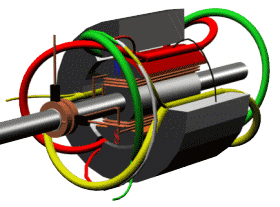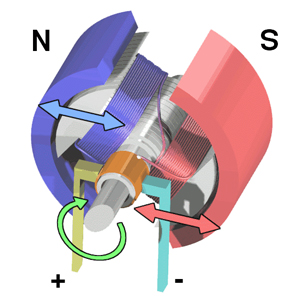Brushed DC Motor Basics
A brushed DC electric motor is a rotating electrical machine containing a brush device that converts electrical energy into mechanical energy or converts mechanical energy into electrical energy. The brushed DC motor is the basis of all motors. It has the characteristics of fast starting, timely braking, smooth speed regulation in a wide range, and simple circuit control.
Brushed DC motor components
 BDC electric motors are mainly composed of stators, rotors, carbon brushes and commutators.
BDC electric motors are mainly composed of stators, rotors, carbon brushes and commutators.
Stator
The stator generates a fixed magnetic field around the rotor. This magnetic field can be generated by permanent magnets or electromagnetic windings.
Rotor/ Armature
The rotor, also called the armature, consists of one or more windings. When these windings are energized, a magnetic field is created. The poles of the rotor field will attract the opposite poles of the stator field, causing the stator to rotate. As the motor rotates, the windings are continuously energized in a different order, so the poles produced by the rotor never overlap those produced by the stator.
Carbon brushes
The function of the carbon brush device is to introduce or draw out the DC voltage and the DC current. It is mainly composed of a brush, a brush holder and a conductive copper wire. The brush is a conductive block composed of graphite or metal graphite. The tightening spring is placed on the surface of the commutator with a certain pressure, and forms a sliding contact with the surface of the commutator when rotating. The brush holder is clamped on the brush rod with a screw.
Commutator
Unlike brushless DC motors and AC induction motors, BDC electric motors do not require a controller to switch the direction of the current in the electrode windings, but the commutation of the brush DC motor windings is done mechanically. A segmented copper sleeve, called a commutator, is installed on the shaft of the BDC motor. As the motor rotates, the carbon brushes slide along the commutator, making contact with the different segments of the commutator. These segments are connected to different rotor windings, so when energized through the motor's brushes, a dynamic magnetic field is created inside the motor. It is important to note that the brushes and commutators are the most wearable parts of a BDC motor due to relative slippage between them.
Brushed DC motor working principle
 When the motor is working, the coil and the commutator rotate, but the magnetic steel and the carbon brush do not rotate. The alternating change of the current direction of the coil is accomplished by the commutator and brush that rotate with the motor. The stator has magnetic poles (winding type or permanent magnet type), and the rotor has windings. After electrification, a magnetic field is also formed on the rotor. There is an angle between the magnetic poles of the stator and the rotor. Under the mutual attraction of the stator and rotor magnetic fields (between N and S poles), the motor rotates. By changing the position of the brush, the direction of the angle between the stator and rotor magnetic poles can be changed, thereby changing the rotation direction of the motor. Assuming that the starting side of the angle between the magnetic poles of the stator and the other side of the magnetic pole of the rotor, the direction from the magnetic pole of the rotor to the magnetic pole of the stator is the rotation direction of the motor.
When the motor is working, the coil and the commutator rotate, but the magnetic steel and the carbon brush do not rotate. The alternating change of the current direction of the coil is accomplished by the commutator and brush that rotate with the motor. The stator has magnetic poles (winding type or permanent magnet type), and the rotor has windings. After electrification, a magnetic field is also formed on the rotor. There is an angle between the magnetic poles of the stator and the rotor. Under the mutual attraction of the stator and rotor magnetic fields (between N and S poles), the motor rotates. By changing the position of the brush, the direction of the angle between the stator and rotor magnetic poles can be changed, thereby changing the rotation direction of the motor. Assuming that the starting side of the angle between the magnetic poles of the stator and the other side of the magnetic pole of the rotor, the direction from the magnetic pole of the rotor to the magnetic pole of the stator is the rotation direction of the motor.
Types of BDC motors
Shunt-wound DC brush motor
When the excitation coil is connected in parallel with the rotor winding, it is called a Shunt-wound DC brush motor. The stator of this type of motor is not a permanent magnet, but an electromagnetic stator. The coil used to generate the electric field and the rotor coil use the same DC power supply. With low starting torque, it can always run at almost constant speed no matter how big the load is.
Series-wound DC brush motor
When the excitation coil is connected in series with the rotor winding, it is called a Series-wound DC brush motor. The stator of this type of motor is also not a permanent magnet, but an electromagnetic stator. It uses the same DC power supply as the rotor coil for generating the electric field and has good starting characteristics. The speed drops sharply when the load is increased.
Compound-Wound DC brush motor
The Compound-Wound DC brush motor is a combination of shunt and series motors. This DC brushed motor can generate both series excitation and parallel excitation magnetic fields. This motor is with greater torque and better speed control.

